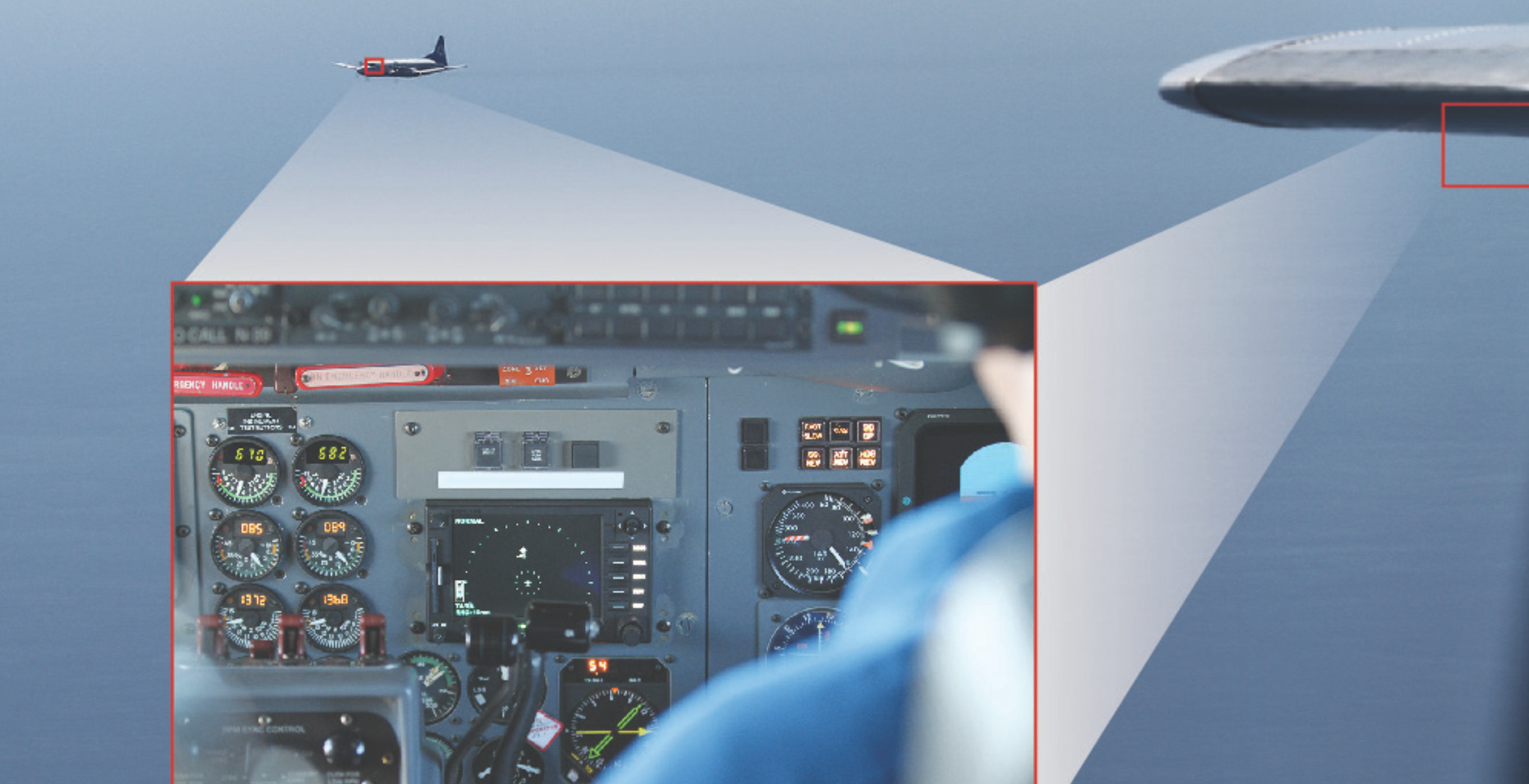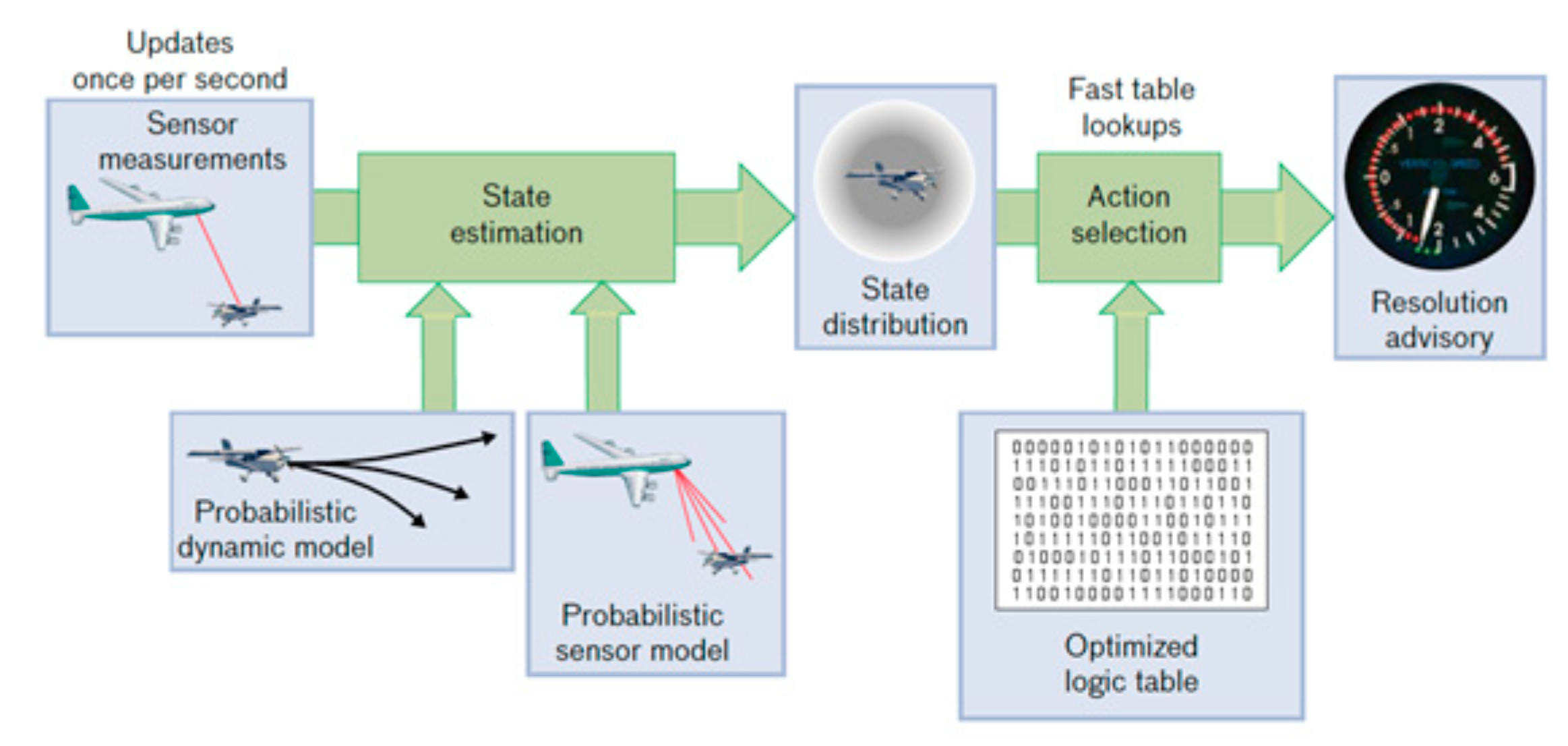Tech notes
Airborne Collision Avoidance System X
A next-generation onboard safety system that uses a new approach to collision avoidance logic reduces mid-air collision risk and extends collision avoidance protection to new aircraft classes.
Since the 1970s, Lincoln Laboratory has participated in the development, implementation, and improvement of an onboard collision avoidance system on behalf of the Federal Aviation Administration (FAA). The current Traffic Alert and Collision Avoidance System II (TCAS II), mandated worldwide on all large commercial aircraft since 2000, has proven to be highly effective in preventing mid-air collisions.
 The Airborne Collision Avoidance System X is a next-generation onboard safety system that detects and tracks other aircraft, assesses potential collision risks, and issues advisories to prevent mid-air collisions.
The Airborne Collision Avoidance System X is a next-generation onboard safety system that detects and tracks other aircraft, assesses potential collision risks, and issues advisories to prevent mid-air collisions.But major transformations to the National Airspace System are being implemented through the FAA's Next-Generation Air Transportation System (NextGen). With the goal of reducing gridlock in the sky and at airports across the United States, NextGen is leveraging new surveillance and navigation capabilities and adopting new technologies and procedures that will enable planes to fly closer together, follow more direct routes, and better coordinate takeoffs and landings. TCAS II would be unable to support these NextGen operations without undergoing significant costly and time-consuming modifications.
In response, Lincoln Laboratory has been developing and maturing the Airborne Collision Avoidance System X (ACAS X), an airborne avionics safety system that pioneers the application of a decision-theoretic approach to collision avoidance logic, taking advantage of recent advances in computational techniques. Unlike TCAS II's rule-based logic, ACAS X's logic employs probabilistic models to represent various sources of uncertainty (e.g., pilot nonresponse, surveillance errors, etc.) and computer optimization to consider safety and operational objectives as defined by system experts and operational users. This new flexible approach to collision avoidance logic is fully compatible with NextGen airspace procedures and technologies.
How It Works
ACAS X detects and tracks aircraft by receiving sensor measurements from onboard surveillance systems and estimates the relative position and velocity of nearby aircraft using advanced tracking algorithms. To compensate for imperfect sensors, a surveillance and tracking module explicitly takes measurement and dynamic uncertainty into account by representing relative positions and velocities as a probabilistic state distribution. To assess potential collision risks, ACAS X uses computer-optimized logic lookup tables that capture each possible state in the probabilistic state distribution. Dynamic programming is used to solve Markov decision processes in the creation of these tables, which are used on board an aircraft. The tables provide a cost for each action—no alert, a traffic advisory alerting pilots about nearby aircraft, or a resolution advisory directing pilots to increase or maintain their existing separation from threat aircraft. This cost is combined with the weighted states to provide a single, optimal action. If a collision avoidance alert is necessary, this information is sent via a data bus to the flight deck displays and aural annunciators to provide pilots with the guidance corresponding to the optimal action.
 Once per second, ACAS X ingests and processes surveillance data and determines the optimal action for every target aircraft.
Once per second, ACAS X ingests and processes surveillance data and determines the optimal action for every target aircraft.Compatibility with NextGen
ACAS X's performance is easily tuned with computer optimization processes to provide collision avoidance that is compatible with evolving NextGen airspace procedures: reduced en route separation standards, closely spaced parallel runway operations, and other new precision flight procedures that will bring aircraft flying closer together to increase arrival and departure rates at airports and to shorten flight times. The system's flexible surveillance architecture supports the use of the NextGen-adopted Automatic Dependent Surveillance–Broadcast (ADS–B) satellite-based positioning system that allows air traffic controllers and pilots to see an aircraft's position, speed, and altitude with much greater precision, accuracy, and reliability than possible with traditional ground-based radar surveillance systems. ACAS X is also compatible with other surveillance sources such as electro-optical and infrared sensors, which enable unmanned aircraft to detect the position and velocity of other aircraft. Because ACAS X logic can be tailored to meet specific performance requirements, unmanned aircraft will be equipped with collision avoidance protection—a prerequisite to enter shared airspace—and thus be granted unrestricted access the National Airspace System for the very first time. Similarly, ACAS X logic can be optimized to provide horizontal advisories, or turns, for low-performance general-aviation aircraft that cannot climb or descend at the high rates required by TCAS II.
Four Variants
ACAS X offers collision avoidance protection to aircraft classes with varying operations and performance capabilities through four interoperable variants:
- ACAS Xa (active) provides global protection against tracked aircraft while incorporating new surveillance sources.
- ACAS Xo (operation) provides operation-specific alerts during intentionalprocedures such as closely spaced parallel runway approaches.
- ACAS Xu (unmanned) is optimized for unmanned aircraft systems (UAS).
- ACAS Xp (passive) passively tracks threats for low-performance general-aviation aircraft that currently lack certified collision avoidance protection.
Benefits of ACAS X
Besides being compatible with NextGen, ACAS X improves the safety of air travel and provides more operational suitability than does TCAS II; studies show that ACAS X reduces mid-air collision risk by 59% and unnecessary disruptive alerts by 25% when compared to TCAS II. In addition to protecting the traveling public on board every large commercial aircraft worldwide, ACAS X will
- Be well-received by pilots (by reducing the number of confusing and surprising advisories)
- Accommodate new surveillance inputs that provide more detailed and precise tracking data than do the currently used onboard transponders
- Contribute to reduced fuel costs, emissions, and flight operating times, as well as increased arrival rates at airports
- Minimize the number of interruptions to normal air traffic flow
- Ease manufacturing operations and costs associated with system implementation and upgrades
- Facilitate the use of unmanned aircraft in defense and commercial applications
Flight Tests and Standards Development
In 2013, the FAA successfully conducted proof-of-concept flight tests of an ACAS Xa prototype flown in more than 120 encounter scenarios. In 2014, the FAA completed an initial ACAS Xu flight test in conjunction with the National Aeronautics and Space Administration and General Atomics. This test represented the first time that a coordinated automatic response was employed by a UAS to resolve collision avoidance conflicts. A full system ACAS Xa flight test is scheduled in August 2015; a follow-on ACAS Xu flight test is planned in 2016. Development of the international Minimum Operational Performance Standards for ACAS Xa is ongoing while the system undergoes further optimization and fine-tuning. After these standards are published in 2018, flight evaluations will be conducted. It is expected that ACAS Xa will subsequently be installed in more than 30,000 transport-category passenger and cargo aircraft worldwide.
Posted June 2015
top of page